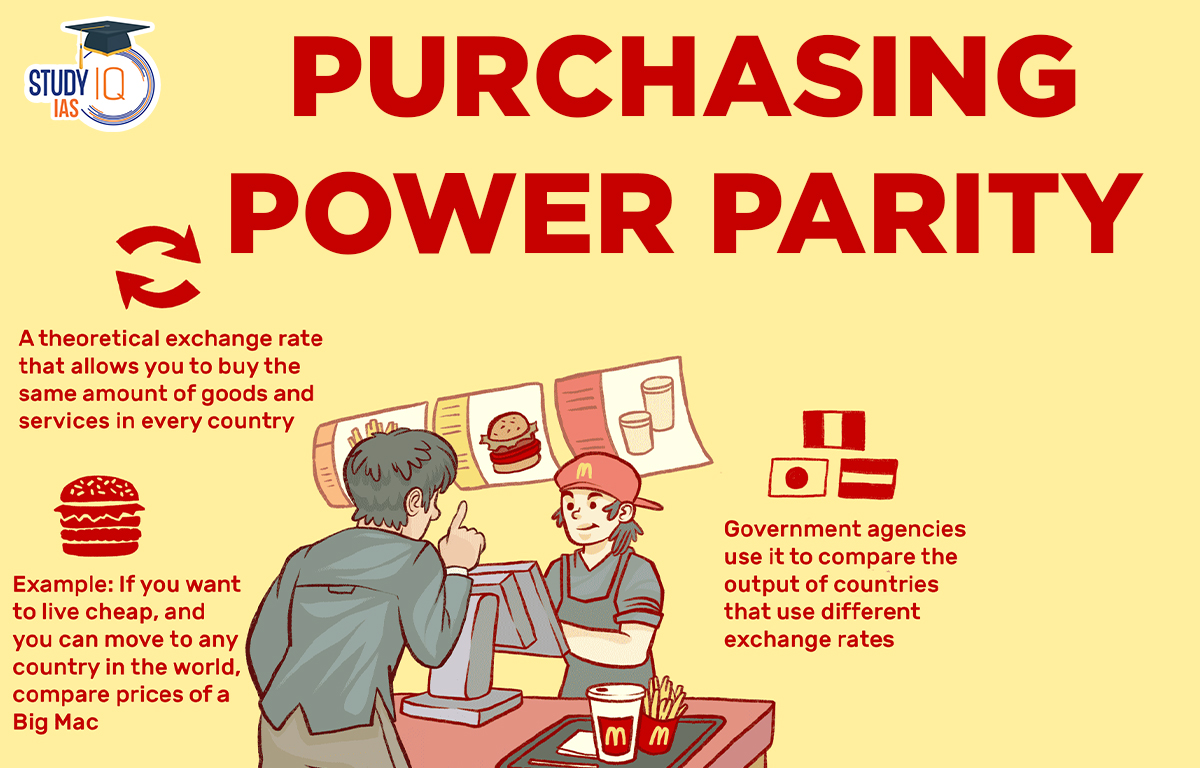Table of Contents
Context: According to a report by EY, India is set to become the world’s second-largest economy in Purchasing Power Parity (PPP) terms by 2038.
Purchasing Power Parity (PPP)
Purchasing Power Parity (PPP) is an economic concept that measures the value of a country’s currency in terms of its ability to purchase goods and services, relative to another country’s currency. In other words, PPP is a method used to compare the economic output and living standards of different countries by taking into account differences in the cost of living and inflation rates.
- The PPP Index adjusts GDP and incomes for price level differences across countries, making it a more accurate tool for comparing real living standards and economic size than nominal GDP.
- It shows how much currency is needed in one country to buy the same basket of goods and services in another country.
- Difference from Market Exchange Rate (MER):
- PPP: Reflects the cost of living and real purchasing power.
- MER: Reflects the demand and supply of currencies in forex markets.
- Top 3 economies according to PPP: China 2. USA 3. India
Purchasing Power Parity Theory
Purchasing Power Parity (PPP) is based on the idea that in a perfectly efficient market, identical goods and services should have the same price in different countries, once the exchange rate is taken into account. For example, if a basket of goods and services costs $100 in the United States and 100 euros in Germany, the exchange rate between the dollar and the euro should be 1:1 to reflect equal purchasing power in both countries.
PPP is often used to compare the relative economic well-being of countries, particularly in terms of their GDP per capita. It is also used to make cross-border price comparisons and to determine exchange rates that are more reflective of the true economic value of different currencies.
How to Calculate Purchasing Power Parity Index?
Purchasing Power Parity (PPP) is typically calculated using a basket of goods and services that are representative of the average consumption patterns in each country being compared. The basic idea is to determine the cost of a basket of goods in one country, and then convert that cost into the currency of another country using the exchange rate.
The following steps are involved in calculating Purchasing Power Parity:
- Choose a Basket of Goods and Services: The first step is to choose a basket of goods and services that are commonly consumed in both countries being compared. This basket might include items like food, clothing, housing, transportation, and healthcare.
- Determine the Cost of the Basket in Each Country: The cost of the basket of goods and services is then determined in each country using the local currency. This is usually done by surveying prices in local markets.
- Convert the Cost into a Common Currency: The cost of the basket in each country is then converted into a common currency using the current exchange rate between the two currencies.
- Calculate the PPP Exchange Rate: The PPP exchange rate is then calculated by dividing the cost of the basket in one country by the cost of the basket in the other country, both in the same currency.
- Compare the PPP Exchange Rate to the Market Exchange Rate: Finally, the PPP exchange rate is compared to the market exchange rate to determine whether a currency is overvalued or undervalued. If the PPP exchange rate is higher than the market exchange rate, the currency is considered undervalued, and if the PPP exchange rate is lower than the market exchange rate, the currency is considered overvalued.
While PPP calculations can be complex and subject to a number of variables, the basic idea is to create a more accurate comparison of economic well-being between countries by taking into account differences in the cost of living and inflation rates.
Purchasing Power Parity: India vs USA
In PPP terms, India’s economy is much larger than when calculated in nominal GDP, since Indian goods and services are less expensive than in the USA.
- India (PPP GDP 2024 est.): Approximately $16–17 trillion, the 3rd largest following China and the USA.
- USA (PPP GDP 2024 est.): Approximately $29–30 trillion, the 2nd largest following China.
- Cost of Living: $1 USD will purchase as many goods/services as approximately ₹20–25 in India (as opposed to the nominal ₹83/USD exchange rate), which indicates India’s lower price levels.
India’s PPP-adjusted economy is much nearer that of the USA’s, indicating its real consumption and production power notwithstanding a lower nominal GDP.
Differences in Average Incomes
One of the primary reasons for differences in PPP between countries is differences in average incomes. India has a lower per capita income compared to the United States, which means that the prices of goods and services in India are generally lower.
Differences in Cost of Production
The cost of producing goods and services in India is generally lower than in the United States due to differences in labour costs, energy costs, and other factors. This leads to lower prices for goods and services in India.
Differences in Currency Exchange Rates
The exchange rate between the Indian rupee and the US dollar is also a factor in determining the PPP between the two countries. Fluctuations in the exchange rate can impact the PPP calculation.
Differences in Taxation and Regulation
Taxation and regulation can impact the cost of goods and services in different countries. Differences in tax rates and regulations can lead to differences in prices for the same goods and services in different countries.
Overall, the differences in PPP between India and the United States reflect the differences in their respective economic structures, with India having a lower average income and lower cost of production compared to the United States.
Purchasing Power Parity of India
India’s position in the global ranking of purchasing power parity (PPP) varies depending on the source of the data and the year. According to the World Bank‘s latest PPP data for 2020, India is ranked third globally in terms of PPP-adjusted GDP, behind only the United States and China. However, India’s per capita PPP-adjusted GDP is much lower, ranking 126th globally in 2020. The factors that determine India’s PPP include:
Average Incomes
As mentioned earlier, one of the primary factors that determines PPP is the average income level of a country. India has a relatively low per capita income compared to developed countries like the United States, which contributes to a lower PPP.
Cost of Production
The cost of producing goods and services in India is generally lower compared to developed countries, which leads to lower prices and a higher PPP.
Exchange Rates
Exchange rates can impact the PPP calculation, and fluctuations in the value of the Indian rupee against other currencies can affect India’s PPP ranking.
Economic Policies and Regulations
Policies and regulations related to taxation, trade, and investment can also impact the cost of goods and services in India and affect the country’s PPP.
Inflation Rates
Inflation can also affect the PPP calculation, as it can lead to changes in the cost of living in different countries.
Why India is Projected to Rise?
- Demographic Dividend: Median age in 2025: 8 years → younger workforce compared to ageing West and China.
- Strong Savings & Investment Rates: Higher domestic savings → financing for infrastructure and industries.
- Debt Sustainability: debt-to-GDP ratio projected to fall from 81.3% (2024) to 75.8% (2030).
- Structural Reforms & Technology: GST, Insolvency and Bankruptcy Code (IBC), PLI schemes, AI & digital adoption.
- Vision 2047: Trajectory aligns with India’s long-term vision of becoming a developed nation (Viksit Bharat) by 2047.
| Related Articles | |
| GDP of Indian States | Types of Inflation |
| Inflation | Basel Norms |


 Unemployment Rate in India, Current Rate...
Unemployment Rate in India, Current Rate...
 RBI Monetary Policy Committee: Repo Rate...
RBI Monetary Policy Committee: Repo Rate...
 Goods and Services Tax (GST), Objectives...
Goods and Services Tax (GST), Objectives...

























